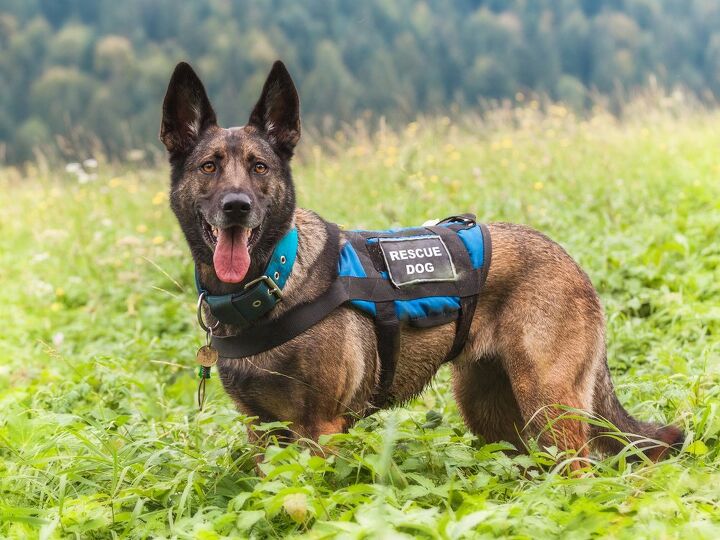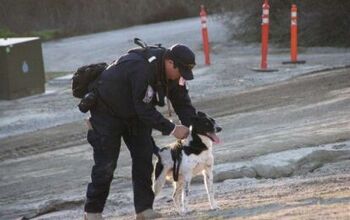How To Train a Search and Rescue Dog

So, your little kipper has proven highly successful at finding and recovering errant treats from between the sofa cushions. And now you’re thinking he might just have what it takes to move up the ranks to search and rescue status. Let’s be honest, you may be over-estimating your dog’s seek-and-find skillset. Then again, maybe you’re not.
You see, Search and Rescue (SAR) dogs come in all shapes and sizes. And while most lean towards the Bloodhound, German Shepherd and Retriever set, a lot of what it takes to succeed in this field comes down to personality, a willingness to train and having a strong connection with their handler. If you’re thinking check, check and check… it may be time to explore what goes on behind the scenes when training these unique dogs.
The Role of a Search and Rescue Dog
Just as the name implies, it’s down to search and find followed by a rescue or recovery. These dogs are specifically trained to search for lost or missing people as well as work in the aftermath of natural disasters ranging from earthquakes to floods, avalanches and of course, who can forget the canine teams climbing over the jagged remains of the World Trade Center in 2001.
Working alongside trained handlers (that’s you by the way), SAR dogs bring unique qualifications that are suited to searching vast areas that might otherwise take a search team days to cover. They’re able to hone in on a specific scent, expedite the rescue and ultimately save lives. As a result, this type of dog is specifically trained in the areas of tracking by way of an individual’s scent, a mere trace of scent on the ground such as footprints, or from what’s called “air scent” which is what would be used in a natural disaster when searching for survivors versus specific individuals.
Once their goal has been met and the individual found, an SAR dog is trained to either sit, stay and bark or to return to the handler and lead them to the location.
The Qualifications
Remember what we said about any breed being able to qualify for this specialized training? Here’s where we start zeroing in on the physical requirements your pet will need to possess, the skills he will need to learn as well as the tasks he will need to perform.
Size and Strength– due to the possibility of onerous jobs that may require your dog to move through rough terrain, he’ll need to be in excellent health, be a medium- to larger-sized breed, and have strong legs and a sturdy body. Some of the more suitable breeds include: Doberman Pinschers, German Shepherd dogs and Labrador Retrievers.
Above Average Olfactory Sense – an SAR dog needs to pick up a scent quickly and be able to track it over long distances, in any weather condition, and often even days after the scent was left. Some of the more suitable breeds include: Bloodhounds, Basset Hounds and Beagles.
Motivated and High Energy – having the tenacity and problem-solving skills to pursue a search regardless of weather conditions, terrain and length of time. Some of the more suitable breeds include: Malinois, Coonhounds and Giant Schnauzers.
Intelligent and Focused – time is always of the essence in any rescue mission and dogs leading the search need to be single-minded, focused and not easily distracted by other animals. Some of the more suitable breeds include: Border Collies, German Shepherd dogs and Labrador Retrievers.
Responsive and Trainable – in a crisis situation, an SAR dog needs to take commands quickly, focus on the task at hand and respond instantly to changing conditions. Some of the more suitable breeds include: Standard Poodle, Border Collies and any type of Pointer.
The Training
Dogs being dogs, it’s likely you’ve met many of these criteria because your pet is already curious, an avid “hunter” and super tenacious. But as the above qualifications show, there’s more to this role than just being a willing participant. And that goes for both you and your dog. In fact, once he’s passed the basics, the rigorous certification process begins. And this is where you’ll want to bring in professional trainers.
According to the Federal Emergency Measures Agency (FEMA), both you and your dog must pass national certification in urban search and rescue before your pooch is ready to go out into the field. It’s typically conducted after your dog reaches the 2-year mark to ensure he is both physically and emotionally mature enough to take on this important work. And the certification must be renewed every 3 years
What we’re offering below are a few simple steps that will help ready you and your pet for the tougher training that follows. Consider it a preliminary test to see if your pooch is ready to advance to the next level.
Five Basic Commands
The first step in turning your dog into an SAR superstar is for him to have completed obedience training – meaning he will instantly respond to the five commands of Sit, Stay, Lay Down, Leave It, and Heel. If he’s not there yet, you’ve got some work to do before you move on to the next phase of training - which can take up to 600 hours before your dog is field ready.
Tracking a Scent
To your dog, this task is just like the games you play at home. He has to find something and you then reward him. When tracking the scent of a particular individual, he’s given their scent through a personal item of clothing and then has to find that individual (who has hidden several yards away). Gradually increase the time and distance to encourage your dog to begin using ground and air scent tracking.
Overcoming Obstacles
Once he’s proven he can track a scent, you need to up the ante by adding obstacles that can include other dogs, or animals, inclement weather, and noisy conditions. And to help motivate his ground scenting, try burying his treats or hiding them in areas where he has to dig to get to them.
When your dog has mastered these skills, he’ll be ready to begin his SAR training where he’ll be tested on his agility, persistence, willingness to continue in poor conditions and ability to deliver a focused bark when communicating back to his handler.
As the handler, you’ll also require training that can include CPR, orienteering skills, crime scene preservation and more. You’ll be tested on these skills as well as your search tactics, mapping, briefing and debriefing skills as well as your dog handling skills.
What Next?
Once you and your dog have received certification, you’ll need to register and your contact details will be given to your local search and rescue organizations. At that point, you’ll be on call for duty as needed. Below are just a few of the nationally recognized SAR organizations that provide training, testing and certification.
- FEMA’s Urban Search and Rescue Certification
- National Search Dog Alliance (NSDA)
- National Association of Search and Rescue (NASAR)
- Search and Rescue Dog of the United States (SARDUS)

Sharing space with three seriously judgy Schnoodles and a feline who prefers to be left alone. #LivingMyBestLife
More by Mary Simpson























